
Coordinates for the Late Ones
GSA Graduate Degree Show, August 2018
A series of works and writing shaped by the process of trying to remember and internalize my mother’s idiosyncratic sense of humor after her death.
![]()
![]()
Installation view, Coordinates for the Late Ones (2018)
concrete, metal, digital print on silk, GPS Sat Nav voice for afterlife
Dimensions variable
voice: Stephanie Black
sound: Jarkko Räsänen
Listen to GPS-voice
GSA Graduate Degree Show, August 2018
A series of works and writing shaped by the process of trying to remember and internalize my mother’s idiosyncratic sense of humor after her death.

Installation view, Coordinates for the Late Ones (2018)
concrete, metal, digital print on silk, GPS Sat Nav voice for afterlife
Dimensions variable
voice: Stephanie Black
sound: Jarkko Räsänen
Listen to GPS-voice
Daily Hauntings
2018
video work
HD 8 min
The ghost of an normal person returns to live out their life. Practices of a spirit-individual, its everlasting attempt to stand out and fit in.
![]()
Objects from Estate (2018)
![]()
pigment print on aluminium, metal, Christmas tree, black sand
Aftercare (2018)
An entry room for a post-mortem spa, photographic installation
![]()
![]()
pigment print on vinyl, print on fabric items, concrete earplugs
Hauntings
2018
This is a text about portraying a ghost. The ghost means a lot of things in this text. Portraying a ghost can mean turning something immaterial into the material. A ghost can be materialized by creating a physical object in which the material and the world outside it meet. A ghost can be a trauma, it can be a shadow whose portrayal may feel as scary as death.
In a more literal sense, portraying a ghost can signify the materialization of a dead person's spirit, either in a photograph, as witnessed by the Victorian “spirit photographers”, or in a domestic object, as every person sorting through a loved one's estate knows.
In my work, the ghost is present in many different ways. It lurks on the surface of a video projection, and in my curiosity about the afterlife. It hangs around ancient ruins of temples where tired tourists wander like ghosts. It emerges on the roads of remote abandoned villages in the shape of winding car skid marks. It is present in the presence, absense and longing that I also deal with in my practice.
Video screen as a fabric of a ghost
I think of the video screen or the projection base as a curtain between the material and the immaterial. It is a surface on which the subconscious and the material world meet and are briefly joined together in the video projection. I like the idea that the projection fabric is a kind of a sheet of a ghost.
A ghost walking around in a sheet can be traced back to the Middle Ages, if not further, when most people couldn't afford a coffin. The corpse was wrapped in a white
cloth, a burial shroud, and wearing this, the deceased could resurface in the world of the living for instance to bring messages.
![]()
Alfonso X, Cantigas de Santa Maria, c. 1272
I see the screen as a kind of curtain between the real world and the afterlife, but also between the material world and the mind's reality. The curtain reminds me of the Red Room in the series Twin Peaks. Its red velvet curtains exist somewhere behind the physical reality, in a space that might be inspired by the director David Lynch's interest in Tibetan Buddhism, and the Bardo - the between-space of different states of consciousness. There are six spaces in transition within the concept of Bardo: the birth, death, dream, meditation, afterlife and spiritual luminosity. I am curious about the states that occur in the everyday life like falling asleep and waking and feelings of uncertainty, absent-mindedness, and writing.
Martin Standard writes in the biography of Muriel Spark: ”That word ”time-space” was Muriel’s invention (an inversion of Einstein’s term), often used in her letters to describe the nebulous mental universe of the artist, half in, half out of the material world.” The world that stays outside of the material world is as real or unreal as the material world. It's important for an artist that these two worlds are in balance. Both worlds must be nurtured and taken care of. There also needs to be a link between the worlds.
The link between the worlds can be like electrically conductive material. The projection screen could be such a thing. The link can be an object that in some way encases both the immaterial and the material. Like a book.
![]()
Object from Estate, pigment print, 2017
”Between it and herself hung only a thin curtain; she could never draw the curtain aside—but sometimes, just for a moment, a wind fluttered it and then it was as if she caught a glimpse of the enchanting realm beyond—only a glimpse—and heard a note of unearthly music.”
L. M. Montgomery: Emily of New Moon (1923)
*
How to capture the ghost in the digital age?
![]()
Error in digital video, still 1.
"No matter how slow the film, Spirit always stands still for the photographer it has chosen.”
The above quotation from photographer Minor White (1908-1976) conveys something essential about the nature of photography as a basically mystical medium. The invention in which ‘the words of light’ hauntingly appear on the paper's surface has certainly lost some of its mysticism over time. The spirit doesn't materialise anymore in the darkroom but in the electricity on the surface of the screen. In order to capture a ghost, the artist has to be more and more conscious of its slow movement.
Sigmund Freud referred to the subconscious as a place “where bits of memory are stored until they are developed, like prints from black and white negatives.” The reference to the subconscious as undeveloped film makes me think of the ghost as an embodiment of trauma. The materialisation of the ghost happens in this instance on the surface of paper or other material, as a mark forming on a two dimensional image.
The ghost is an echo of the past: the part of us that has remained subconscious.
![]()
Error in digital video, still 2.
When you try to materialise a ghost, there's no hurry. The trauma stays on until it is found and one has become conscious of it. In gestalt therapy it is believed that once you become conscious of the trauma, a healing process begins, which it is impossible to consciously rush. Once the ghost has become visible, it begins to fade, as a film photograph fades over time.
Taking your time was also something that experimental filmmaker Philip Hoffman emphasised in his workshop in October 2016. Hoffman told us to choose a place, sit down and let the video camera roll for twenty minutes. For many of us, frustration turned into meditation and things started happening in front of the camera. In other words, the spirit started to materialize.
When listening to ghost stories, it becomes apparent that a ghost is inseparable from its environment. Much like how trauma lingers in the certain part of the body, the ghost has its preferred room in the house. The spirit pixelates into and out of the landscape, always in relation to its surroundings. “What happens to people and what happens to the land is the same thing”, Linda Hogan writes in her book Dwellings: A Spiritual History of the Living World. What we do to our communities can be felt in the landscape and vice versa.
Photographing in the digital age has become faster and one can capture dozens of photographs in a minute like a splash of water. Coincidence – and therefore the unconscious – plays a different kind of role. Perhaps instead of the slow process of waiting there's another kind of method; a fast, spontaneous process that produces thousands of photos from which the photographer can finally find the embodiment of the ghost. If the photographer is not ready to encounter their subconscious, they can much more easily efface the phantom.
In digital photography the ghost materialises in the changes of the pixel order. Can the rearrangement of pixels be compared with those of the cells that takes place when the mind deals with a traumatic event?
![]()
Error in a digital image
Sources: Ulrich Baer: Spectral Evidence - The Photography of Trauma, 2002 / Handbook of Material Culture by Christopher Y. Tilley, Webb Keane, Susanne Küchler, Michael Rowlands, Patricia Spyer, 2006 / The Ashgate research companion to paranormal cultures by Munt, Sally and Jenzen, Olu, eds. 2013 / Margaret Iversen: Photography, Trace, and Trauma, 2017 / Antroblogi: Alitajunnan antropologiaa – havaintoja David Lynchin maailmasta / Martin Stannard: Muriel Spark - The Biography, 2009 / L. M. Montgomery: Emily of New Moon, 1923 / Psychotherapy changes gene expression: https://heartsinhealthcare.com/psychotherapy-changes-gene-expression-new-research/ Linda Hogan: Dwellings: A Spiritual History of the Living World
2018
video work
HD 8 min
The ghost of an normal person returns to live out their life. Practices of a spirit-individual, its everlasting attempt to stand out and fit in.
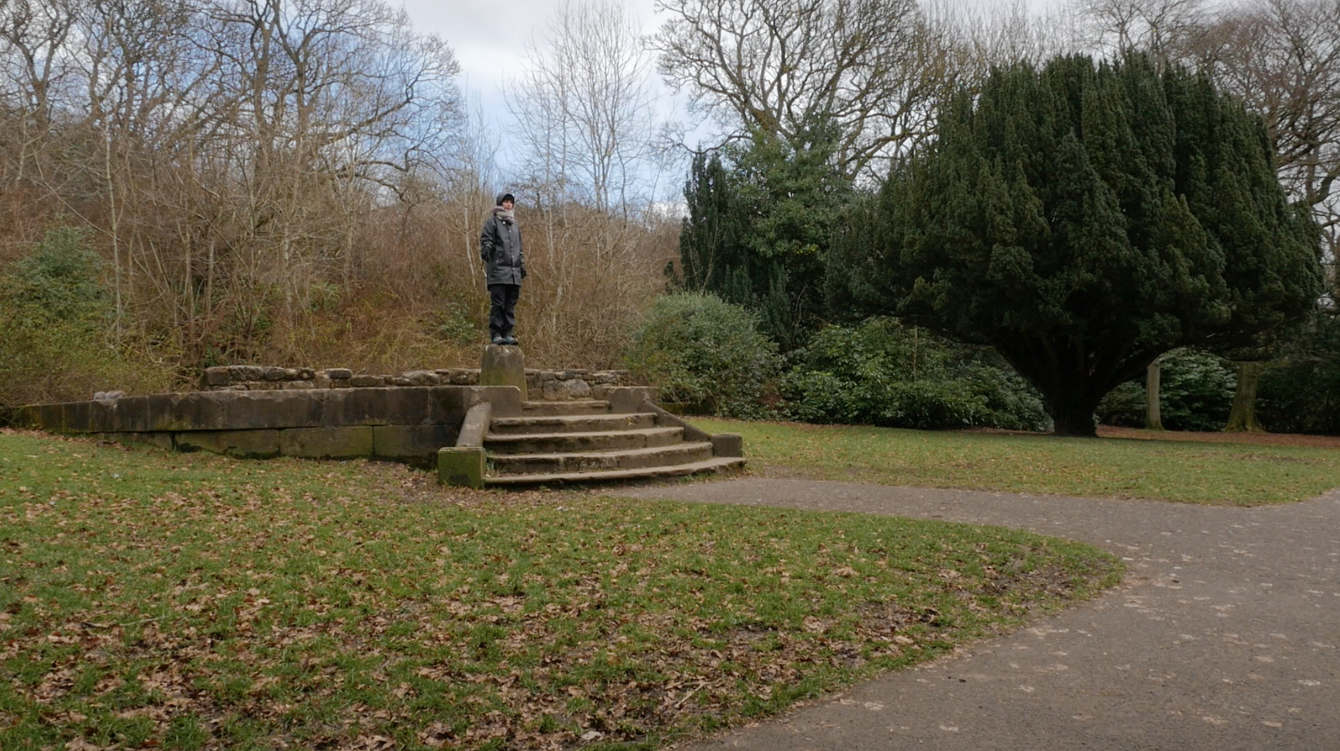
Objects from Estate (2018)
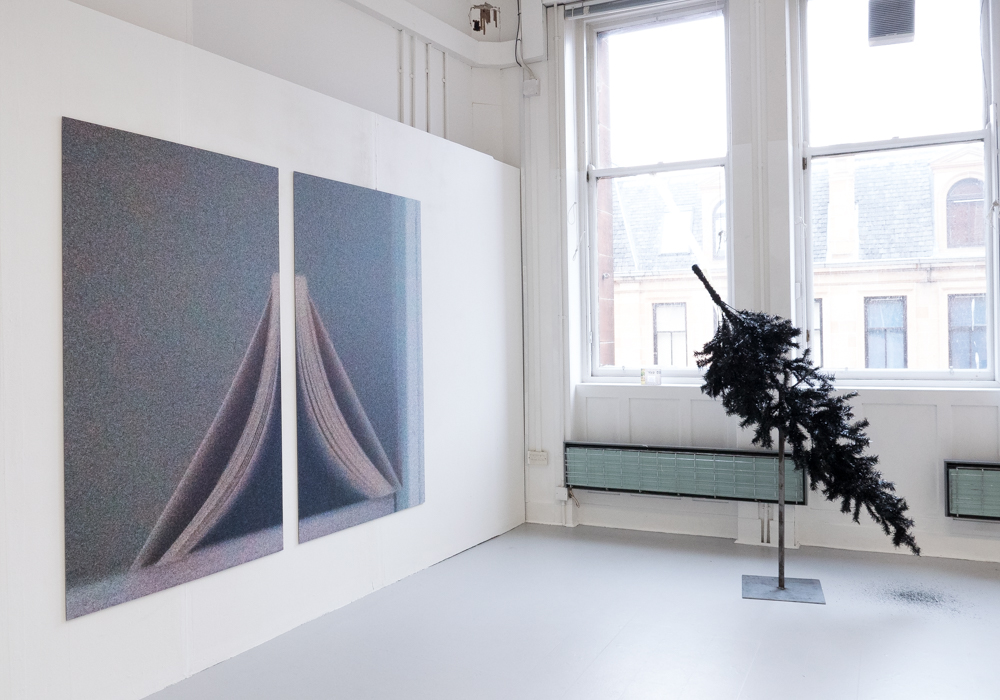
pigment print on aluminium, metal, Christmas tree, black sand
Aftercare (2018)
An entry room for a post-mortem spa, photographic installation
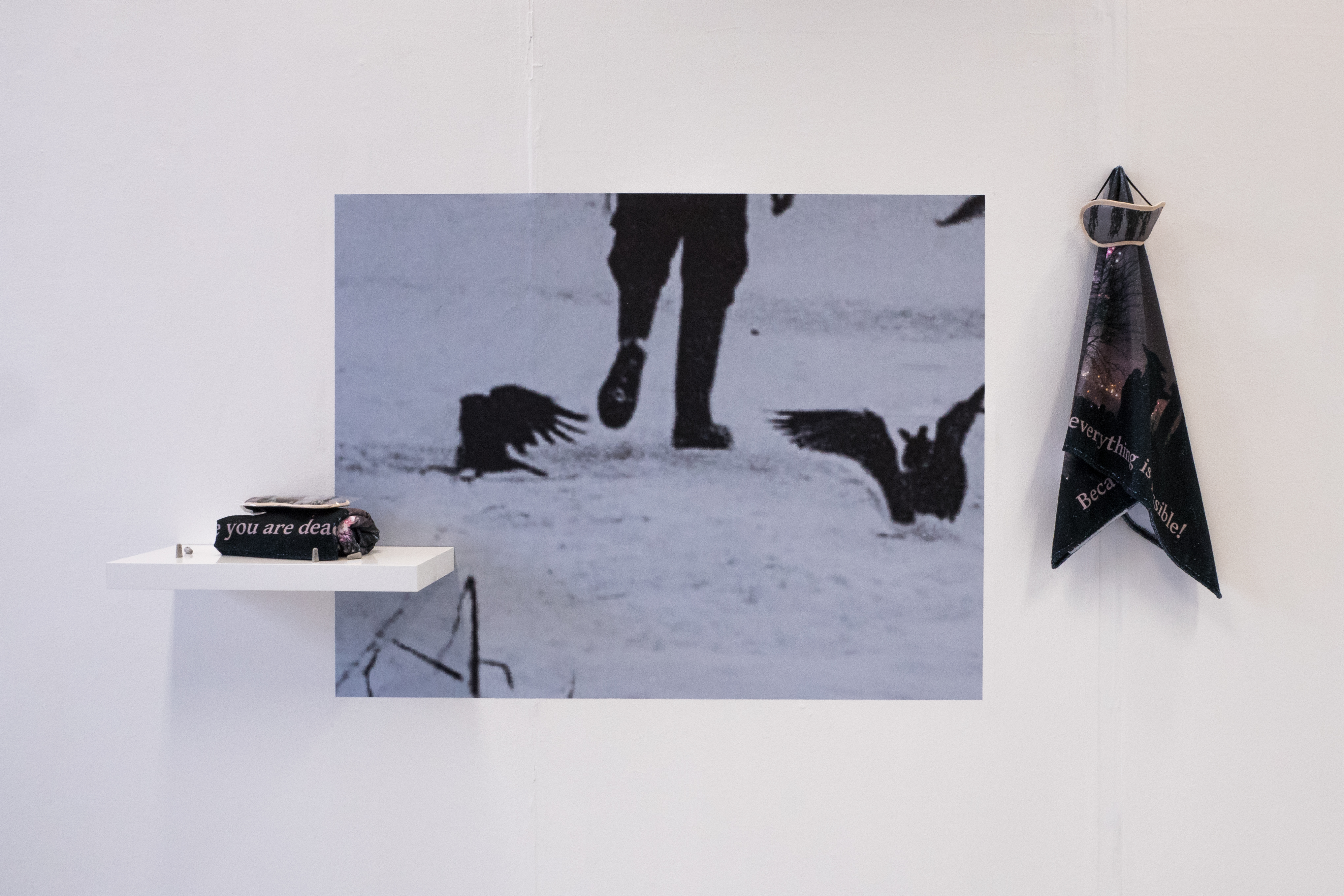
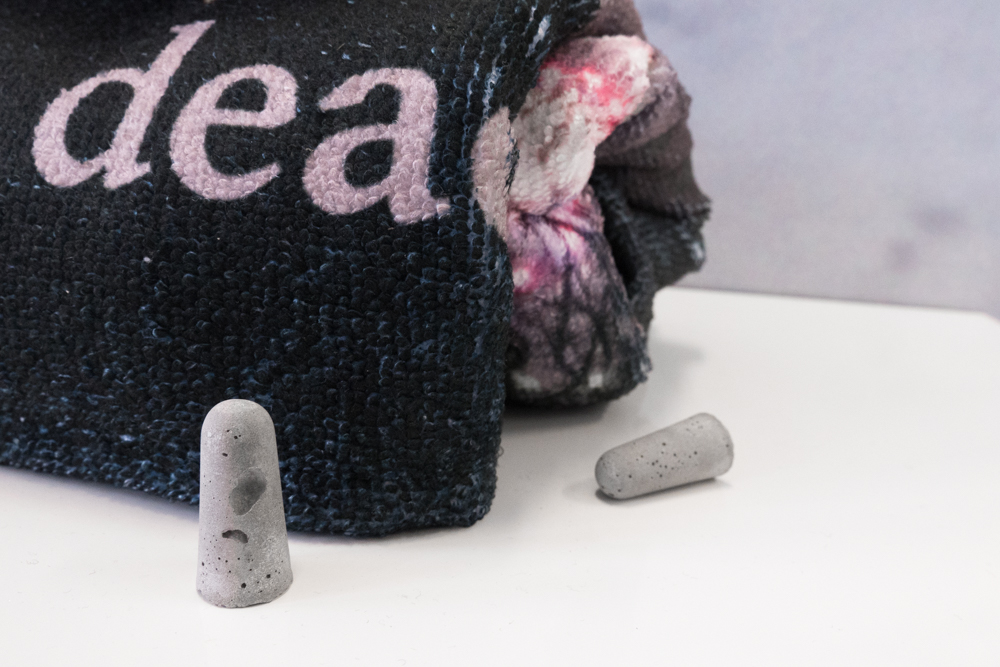
pigment print on vinyl, print on fabric items, concrete earplugs
Hauntings
2018This is a text about portraying a ghost. The ghost means a lot of things in this text. Portraying a ghost can mean turning something immaterial into the material. A ghost can be materialized by creating a physical object in which the material and the world outside it meet. A ghost can be a trauma, it can be a shadow whose portrayal may feel as scary as death.
In a more literal sense, portraying a ghost can signify the materialization of a dead person's spirit, either in a photograph, as witnessed by the Victorian “spirit photographers”, or in a domestic object, as every person sorting through a loved one's estate knows.
In my work, the ghost is present in many different ways. It lurks on the surface of a video projection, and in my curiosity about the afterlife. It hangs around ancient ruins of temples where tired tourists wander like ghosts. It emerges on the roads of remote abandoned villages in the shape of winding car skid marks. It is present in the presence, absense and longing that I also deal with in my practice.
Video screen as a fabric of a ghost
I think of the video screen or the projection base as a curtain between the material and the immaterial. It is a surface on which the subconscious and the material world meet and are briefly joined together in the video projection. I like the idea that the projection fabric is a kind of a sheet of a ghost.
A ghost walking around in a sheet can be traced back to the Middle Ages, if not further, when most people couldn't afford a coffin. The corpse was wrapped in a white
cloth, a burial shroud, and wearing this, the deceased could resurface in the world of the living for instance to bring messages.
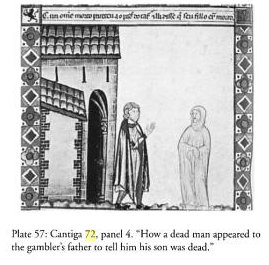
Alfonso X, Cantigas de Santa Maria, c. 1272
I see the screen as a kind of curtain between the real world and the afterlife, but also between the material world and the mind's reality. The curtain reminds me of the Red Room in the series Twin Peaks. Its red velvet curtains exist somewhere behind the physical reality, in a space that might be inspired by the director David Lynch's interest in Tibetan Buddhism, and the Bardo - the between-space of different states of consciousness. There are six spaces in transition within the concept of Bardo: the birth, death, dream, meditation, afterlife and spiritual luminosity. I am curious about the states that occur in the everyday life like falling asleep and waking and feelings of uncertainty, absent-mindedness, and writing.
Martin Standard writes in the biography of Muriel Spark: ”That word ”time-space” was Muriel’s invention (an inversion of Einstein’s term), often used in her letters to describe the nebulous mental universe of the artist, half in, half out of the material world.” The world that stays outside of the material world is as real or unreal as the material world. It's important for an artist that these two worlds are in balance. Both worlds must be nurtured and taken care of. There also needs to be a link between the worlds.
The link between the worlds can be like electrically conductive material. The projection screen could be such a thing. The link can be an object that in some way encases both the immaterial and the material. Like a book.

Object from Estate, pigment print, 2017
”Between it and herself hung only a thin curtain; she could never draw the curtain aside—but sometimes, just for a moment, a wind fluttered it and then it was as if she caught a glimpse of the enchanting realm beyond—only a glimpse—and heard a note of unearthly music.”
L. M. Montgomery: Emily of New Moon (1923)
*
How to capture the ghost in the digital age?
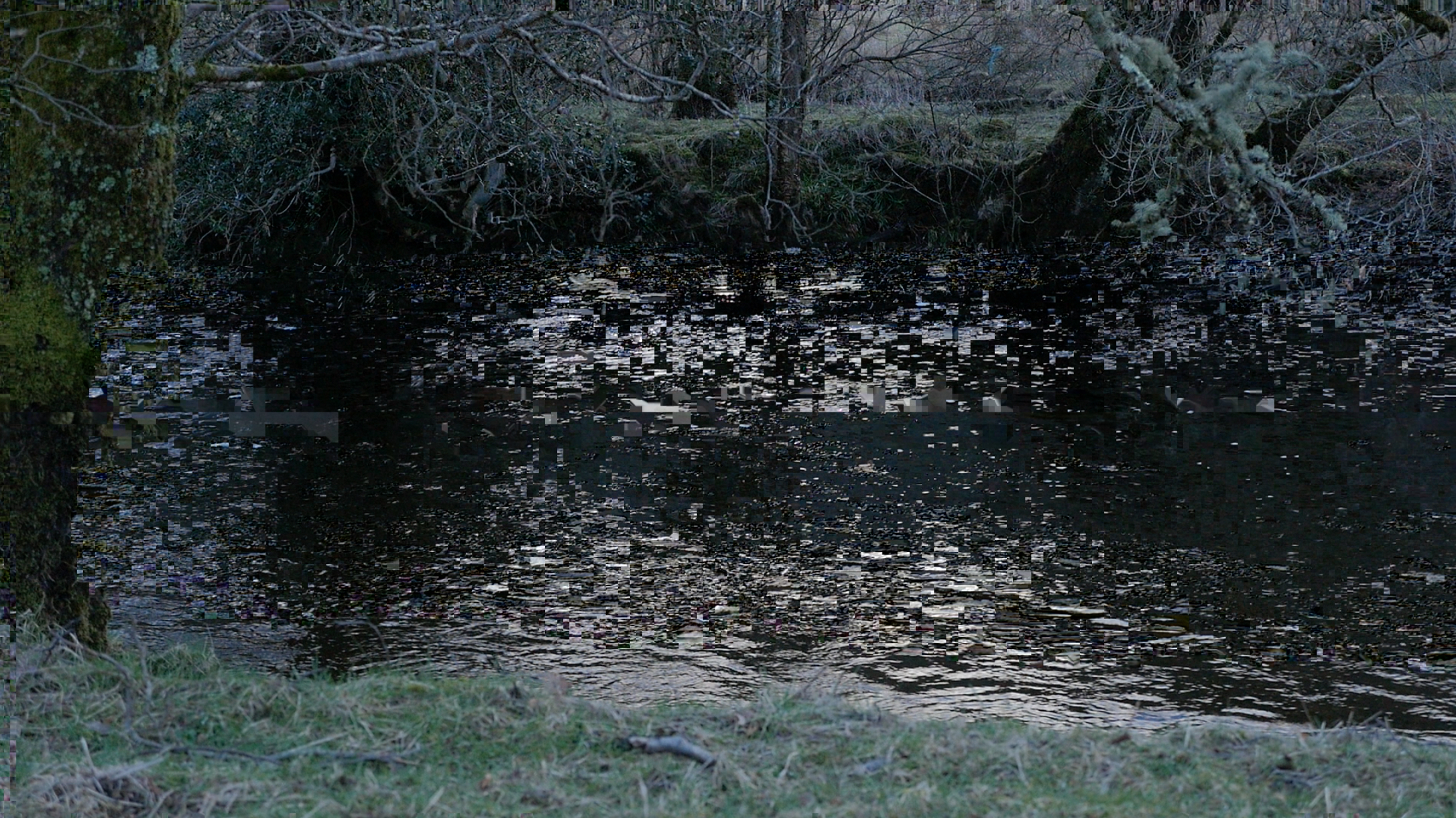
Error in digital video, still 1.
"No matter how slow the film, Spirit always stands still for the photographer it has chosen.”
The above quotation from photographer Minor White (1908-1976) conveys something essential about the nature of photography as a basically mystical medium. The invention in which ‘the words of light’ hauntingly appear on the paper's surface has certainly lost some of its mysticism over time. The spirit doesn't materialise anymore in the darkroom but in the electricity on the surface of the screen. In order to capture a ghost, the artist has to be more and more conscious of its slow movement.
Sigmund Freud referred to the subconscious as a place “where bits of memory are stored until they are developed, like prints from black and white negatives.” The reference to the subconscious as undeveloped film makes me think of the ghost as an embodiment of trauma. The materialisation of the ghost happens in this instance on the surface of paper or other material, as a mark forming on a two dimensional image.
The ghost is an echo of the past: the part of us that has remained subconscious.

Error in digital video, still 2.
When you try to materialise a ghost, there's no hurry. The trauma stays on until it is found and one has become conscious of it. In gestalt therapy it is believed that once you become conscious of the trauma, a healing process begins, which it is impossible to consciously rush. Once the ghost has become visible, it begins to fade, as a film photograph fades over time.
Taking your time was also something that experimental filmmaker Philip Hoffman emphasised in his workshop in October 2016. Hoffman told us to choose a place, sit down and let the video camera roll for twenty minutes. For many of us, frustration turned into meditation and things started happening in front of the camera. In other words, the spirit started to materialize.
When listening to ghost stories, it becomes apparent that a ghost is inseparable from its environment. Much like how trauma lingers in the certain part of the body, the ghost has its preferred room in the house. The spirit pixelates into and out of the landscape, always in relation to its surroundings. “What happens to people and what happens to the land is the same thing”, Linda Hogan writes in her book Dwellings: A Spiritual History of the Living World. What we do to our communities can be felt in the landscape and vice versa.
Photographing in the digital age has become faster and one can capture dozens of photographs in a minute like a splash of water. Coincidence – and therefore the unconscious – plays a different kind of role. Perhaps instead of the slow process of waiting there's another kind of method; a fast, spontaneous process that produces thousands of photos from which the photographer can finally find the embodiment of the ghost. If the photographer is not ready to encounter their subconscious, they can much more easily efface the phantom.
In digital photography the ghost materialises in the changes of the pixel order. Can the rearrangement of pixels be compared with those of the cells that takes place when the mind deals with a traumatic event?
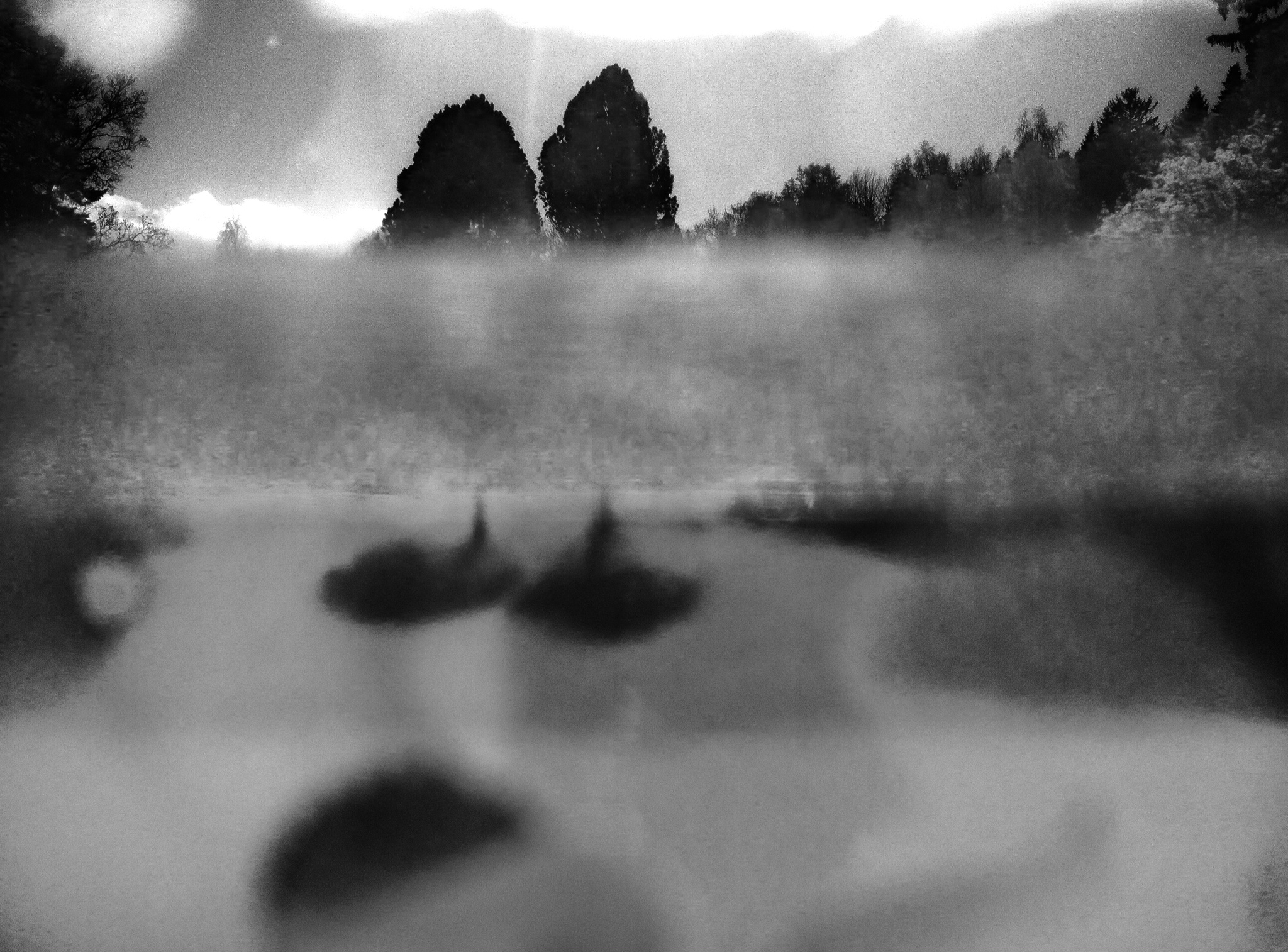
Error in a digital image
Sources: Ulrich Baer: Spectral Evidence - The Photography of Trauma, 2002 / Handbook of Material Culture by Christopher Y. Tilley, Webb Keane, Susanne Küchler, Michael Rowlands, Patricia Spyer, 2006 / The Ashgate research companion to paranormal cultures by Munt, Sally and Jenzen, Olu, eds. 2013 / Margaret Iversen: Photography, Trace, and Trauma, 2017 / Antroblogi: Alitajunnan antropologiaa – havaintoja David Lynchin maailmasta / Martin Stannard: Muriel Spark - The Biography, 2009 / L. M. Montgomery: Emily of New Moon, 1923 / Psychotherapy changes gene expression: https://heartsinhealthcare.com/psychotherapy-changes-gene-expression-new-research/ Linda Hogan: Dwellings: A Spiritual History of the Living World